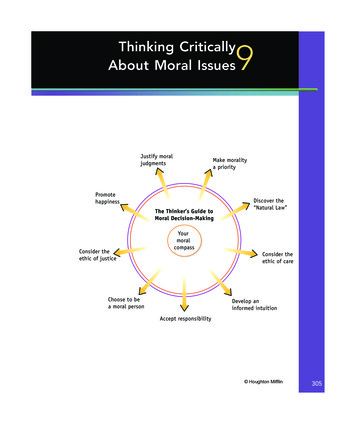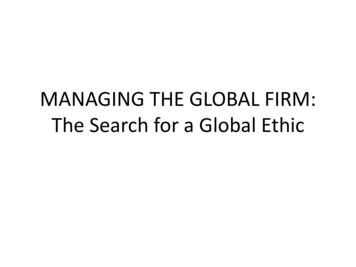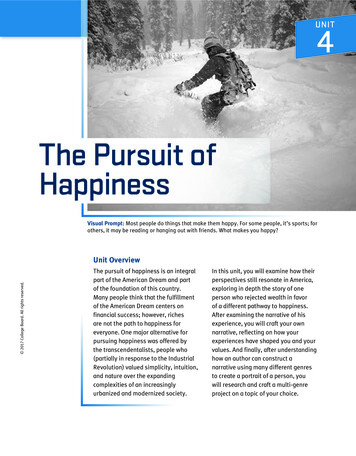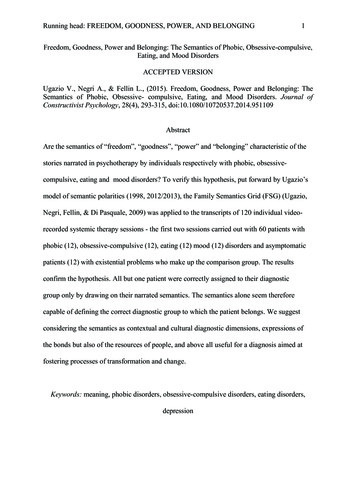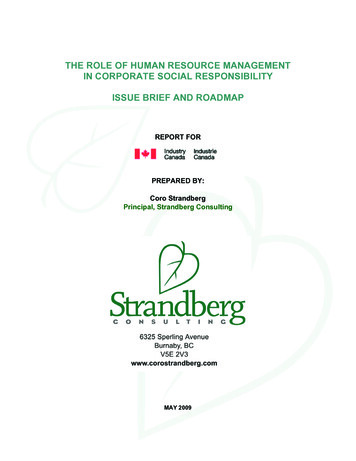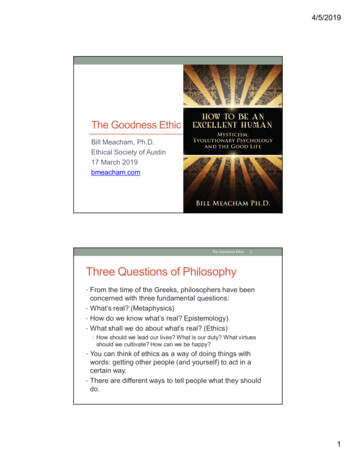
Transcription
4/5/2019The Goodness EthicBill Meacham, Ph.D.Ethical Society of Austin17 March 2019bmeacham.comThe Goodness Ethic2Three Questions of Philosophy From the time of the Greeks, philosophers have beenconcerned with three fundamental questions: What’s real? (Metaphysics) How do we know what’s real? Epistemology) What shall we do about what’s real? (Ethics) How should we lead our lives? What is our duty? What virtuesshould we cultivate? How can we be happy? You can think of ethics as a way of doing things withwords: getting other people (and yourself) to act in acertain way. There are different ways to tell people what they shoulddo.1
4/5/2019The Goodness Ethic3Ways To Say “Should”RightnessGoodnessThe Goodness Ethic4Two Approaches to Ethics There are two ways of approaching ethics, deciding howto guide our actions. Goodness paradigm Has to do with achieving goals. Living beings have desires and aspirations. Value is what enables a being to achieve its ends. Typical virtues: compassion and insight. Rightness paradigm Has to do with obeying rules. People need organization and regulations to live in groups. Value is conformance to rules and doing one’s duty. Typical virtue: conscientious obedience.2
4/5/2019The Goodness Ethic5Two Uses of Language Goodness language Good Helpful, nourishing, beneficial, effective Bad Unhelpful, unhealthy, damaging, ineffective Rightness language Right Proper, legal, correct Wrong Improper, illegal, incorrect When someone makes an ethical judgment, whatlanguage do they use?The Goodness Ethic6Ethics: Quandaries and Virtues Goodness and rightness apply to both. Quandary: focus on specific actions or types of actions What should we do in a specific situation or type of situation? Goodness What are the anticipated benefits and harms of the possible choices? Rightness What do the moral rules say to do? What’s the right choice? Virtue: focus on qualities of character What kind of person should we be? Goodness What will be the effects of our habitual way of being? Rightness What ways of behaving will lead us to obey the rules despite temptation?3
4/5/2019The Goodness Ethic7Good vs. Right Both concepts evaluate actions and tell us what to do. People often mix them, but that creates confusion. Pay attention to the language people use. If someone says something is good, ask “good for what?” If someone says something is right, ask “according to what rule?” Goodness is often called prudential. Rightness is often called moral. As I use the terms, “ethical” is broader than “moral.”Ethics refers to guidance for actions and character ineither paradigm.The Goodness Ethic8The Good Goodness language is about benefits and harms What benefits something or someone is good for that thing orperson. Teleological, from telos, end, purpose or goal Actions are justified by their consequences or effects. Goodness can be instrumental or biological.4
4/5/2019The Goodness Ethic9Goodness as Instrumental What is good for a thing enables it to serve its purpose. Requires reference to a person’s purpose or intention. A hammer is good for pounding nails. Nails are good for building things, such as furniture and housing. Furniture and housing are good for us because they provide usutility and comfort. Some hammers are better than others for the purpose ofpounding nails; they have better heft or balance. Some actions are good for the hammer: keeping it cleanand free of rust. The good for a thing is what enables the thing to functionwell.The Goodness Ethic10Goodness as Biological What is good for an organism promotes its health and wellbeing. The good is what nourishes. Does not require reference to a purpose or intention. Some things are better than others. Whole grains and a balanced diet are better than junk food. Some plants need full sun, some need more shade. Goodness is not absolute. What is good for the hawk isnot so good for the mouse. The good for an organism is what enables the organismto function well. What are the functions of human beings?5
4/5/2019The Goodness Ethic11Premise: Everything is Connected Everything is connected to everything else. Nothing exists in isolation. We all get nutrients from the same environment. We are connected to the entire universe through gravitation. Humans are connected to other humans. We could not live without other humans. Language is essentially communal. Religious: God made us all in His/Her/Its image. Mystical: We are all expressions of the One Being. The book argues for this idea in many ways. For now,take it as a premise to see where the argument leads.The Goodness Ethic12The Goodness Ethic Work for the good in all things. If you want to flourish, act for the benefit of yourself andyour environment. Do the best you can to maximize goodness for all. We are all in it together, so let’s make it good foreverybody. Not altruism, and not selfishness. Go for win-win. Goal: For both you and your environment to thrive. If you do good for what is around you, it will nourish you.6
4/5/2019The Goodness Ethic13Goodness Ethic: Enlightened Self-Interest Maximize the good in all situations because doing so willbenefit you. As you promote the good of your environment youpromote your own good as well. Environment people, animals, plants, non-living things, the earth,the atmosphere, the water, etc. Everything. By working for the good – that is, the healthy functioning –of the world around us, we nourish that which nourishesus, and we thrive. Selfishness is self-defeating.The Goodness Ethic14Not Utilitarianism Utilitarianism says we should maximize the pleasure and minimize the pain of all concerned.“The greatest good for the greatest number.”It looks at consequences but is actually in the Rightnessparadigm. It says our moral duty is to maximize pleasurefor all.Computing the greatest good is unworkable.Goodness Ethic: Maximize the good for all so far as youcan determine at the time, without excessive deliberation.Do so not because it is your duty but because it willbenefit you.7
4/5/2019The Goodness Ethic15Goodness is Contextual What is good for an organism or a person or a tool at onetime or place might not be good at another time or place. The context of human beings is that we are In the world With other people Capable of self-knowledge We have a limited perspective, so just do the best you canto promote goodness in the situation you find yourself in.The Goodness Ethic16The Right An act is justified on the basis of a quality or characteristicof the act itself regardless of its consequences. That quality is conformance to rules and regulations. We apply a rule to determine what to do. Non-ethical: the right answer to a math problem. Ethical: the right answer to a moral problem. Deontological, from deon, duty. Central concerns: identifying the rules and obeying them.8
4/5/2019The Goodness Ethic17Ways To Say “Should”RightnessGoodnessThe Goodness Ethic18What Is Morality? Morality is a system of rules for how people are supposed to act.Under these rules some things are forbidden, others areallowed but not required, and others are mandatory.We have to have rules for getting along with each other.All cultures have moral codes, but the codes differ fromculture to culture. Example: honor killing.Everyone has a sense of morality. The details can varyfrom culture to culture, but everyone has one. We all haveintuitive judgments about whether something is right orwrong.9
4/5/2019The Goodness Ethic19Characteristics of Moral Judgment Cognitive: Moral rules are taken to be universal andobjective. Behavioral: We blame and praise people, punish andreward them, based on the moral rules. Emotional: We feel righteous when we obey the rules and guiltywhen we don’t. We feel angry or resentful at those who don’t obeythem. We feel a desire to recruit others to obey them. (This is a purely descriptive account.)The Goodness Ethic20Trolley Problem – 110
4/5/2019The Goodness Ethic21The Goodness Ethic22Trolley Problem – 2Moral Intuition The trolley problem was originally formulated by Phillipa Foot in 1967.Since then it has been posed to over 200,000 people ofall walks of life from 100 countries.Most people say “Yes” to the first scenario and “No” to thesecond even though the consequences are the same.And they have trouble justifying their choice.People make a moral choice first and justify it afterwards.Most of our moral judgments are “hot cognition,” notthought out carefully.We have moral intuitions. Feelings of approval ordisapproval pop into our minds without deliberate thought.11
4/5/2019The Goodness Ethic23Six Domains of Moral Intuition From research by Jonathan Haidt and others The Righteous Mind (2012) The Happiness Hypothesis (2006) Caring and prevention of harm Fairness and reciprocity In-group loyalty Authority and respect Purity and sanctity Liberty and oppressionThe Goodness Ethic24Evolutionary Roots Apes and monkeys show concern for caring and fairness. Survival depends on how animals fare within their group. Cooperation: concerted action and information sharing. Competition for resources: dominance strategies and deception. “It is in the social domain that one expects the highestcognitive achievements. Selection must have favoredmechanisms to evaluate the emotional states of othersand quickly respond to them.” – Frans deWaal The most potent force to bring a sense of community isenmity toward outsiders.12
4/5/2019The Goodness Ethic25Functions of Moral Rules What are moral rules for? Between people: to promote and regulate socialcooperation. We need rules of behavior so we can get along with each other. Within each person: to promote and regulate personalmotivation and psychology. Morality helps us decide between competing motivations. It enables us to be constructive participants in life with otherpeople.The Goodness Ethic26Ontology of Moral Rules Ontology: how things exist, their manner of being, Moral Realism: Moral rules really exist apart from ourperception of them. Evidence: Universality of certain moral intuitions. The rulescertainly seem to exist. Moral Anti-Realism: No they don’t. Evidence: Culture-specificity. Honor killing is an example. Social Construction: Moral rules are realities that aresocially constructed within a social group. Everybodyagrees (more or less) on what they are, everybody treatsthem the same way and everybody acts as if they arereal.13
4/5/2019Excellent Human – Good and Right27Meta-ethics How shall we decide which language game to play? If we ask which is better, we presuppose the Goodnessparadigm. We can say that people who adopt an ethic of goodness will behealthier and happier than those who adopt an ethic of rightness,but that assumes that goodness is paramount. If we ask which is right, we presuppose the Rightnessparadigm. We can say that people who adopt an ethic based on being rightare morally superior to those who don’t, but that assumes thatrightness is paramount. Not just a theoretical question. Should you lie to protect aJew from the Nazis?The Goodness Ethic28What Shall We Do? Purely descriptive accounts of morality do not tell us how to act. “Is-ought” problem.If moral rules are just social constructs, why should weobey them?You can’t avoid having moral intuitions, but you canchoose what to attach them to.Look at the consequences of obedience or disregard.Think in terms of goodness, not rightness.Moral rules that promote well-being are worth following;moral rules that don’t, aren’t.14
4/5/2019Excellent Human – Morality29The Goodness Ethic15
From research by Jonathan Haidt and others The Righteous Mind (2012) The Happiness Hypothesis (2006) Caring and prevention of harm Fairness and reciprocity In-group loyalty Authority and respect Purity and sanctity Liberty and oppression Six Domains of Moral Intuition The Goodness Ethic 23

